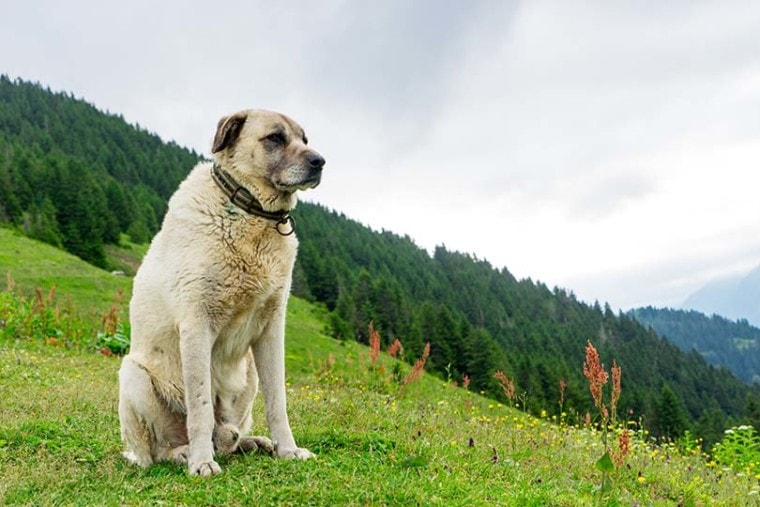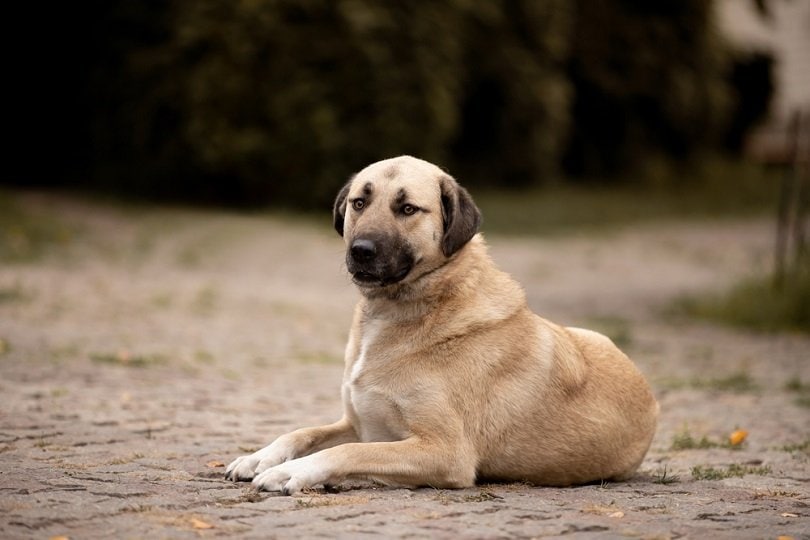
Click Below to Skip Ahead
The Kangal Dog or Anatolian Shepherd is a breed with a presence. Its size is enough to make you take notice. It is an ancient canine with a history that starts in Turkey. Its primary job was as a guardian dog. That purpose differs from herding animals. Their role is to defend livestock against predators1 instead of moving them around a property.
Breed Overview
Height:
27–29 inches
Weight:
80–150 pounds
Lifespan:
11–13 years
Colors:
Gray of various shades with a well-defined black mask
Suitable for:
Individuals or famiiles without kids looking for a calm, large dog
Temperament:
Intelligent, calm, independent, loyal
That fact explains many of the Kangal Dog personality traits. While it’s an affectionate and loyal pet with its owners, it’s not particularly friendly with others. It is not very adaptable and will not tolerate apartment living. The Kangal Dog also isn’t the best choice for first-time pet owners. It’ll do best with experienced individuals that can understand its unique needs and personality.
The thing to bear in mind is that selective breeding and its associated job often determine a pet’s demeanor. The Kangal Dog is a textbook case. It’s also another example where learning a pup’s history is the best way to ensure that it’s a fit with your family and lifestyle.
Kangal Dog Characteristics
Kangal Dog Puppies

The Kangal Dog isn’t a pet for everyone. There are several traits that may take it off the table for many individuals. Its size is the glaring issue. That makes a difference in the cost of owning one and the heightened responsibility for proper training and socialization. The pup is relatively new on the pet circuit. Both the American Kennel Club (AKC) and the United Kennel Club (UKC) recognize the breed.
Like many larger breeds, the Kangal Dog is a surprisingly calm dog. Its appearance may make you think it’s always ready for a fight. Its job demands endurance and stamina. Therefore, this pup conserves energy instead of wasting it needlessly. The gait of the breed is a perfect reflection of its personality. It’s not in a hurry to go anywhere or do anything—unless the circumstances demand it.
Temperament & Intelligence of the Kangal Dog
It never ceases to amaze us how a dog’s job affects its personality as a pet. The Kangal Dog relied on its intelligence and observance to do its work. That shows up even in pups that don’t do the same thing. The traits are ingrained in the breed. In this case, that shows itself as intelligence. A Kangal Dog had to discern friends and foes as a guardian. It learned to recognize the telltale signs.
The Kangal Dog also patrolled the perimeter of its territory on its own. That fosters independence that you often see in hunting breeds. Their jobs didn’t leave a lot of time for an owner to give the signal. The pup had to make snap decisions. You see this trait in this pup. The temperament also reflects its heritage. This breed is reserved and not as overtly friendly as Golden Retrievers.
Are These Dogs Good for Families? 👪
Unfortunately, the Kangal Dog is the best choice for a family dog if there are children in the household. This pup isn’t a kid-friendly breed. That’s not unusual when you consider its purpose. Remember that they are guardian dogs and not herding ones. They aren’t going to round up the little ones as a Border Collie might.
Does This Breed Get Along with Other Pets?
We must go back again to the breed’s job. Other dogs don’t fit into the mix. The size of the Kangal Dog makes it an inappropriate choice in a household with small pets. Its prey drive isn’t strong, but its role makes it see a yapping pup as a threat. Given its size, it’ll be a short fight with a clear winner.
Things to Know When Owning a Kangal Dog:
Researching a breed is essential. It often provides valuable insights into whether a pup is a good fit for your family and lifestyle. It reveals the things any pet owner should know upfront. We’ve covered many of the make-or-break things. Now, it’s time to take about the day-to-day things that can also put the Kangal Dog in the dealmaker or deal-breaker category.
Food & Diet Requirements 🦴
The Kangal Dog is a giant breed that needs a food that reflects its nutritional needs. It’s imperative to offer your pet a diet for dogs of its size. These pups mature more slowly than smaller breeds. Giving your pet the wrong food can lead to nutritional deficiencies because of its different metabolism. Your Kangal Dog will also need a lot of kibble.
You should give your puppy three to four meals a day. That will ensure that its blood sugar levels stay stable during this changeable time in your pet’s life. Your Kangal Dog won’t reach adulthood until it is well over 12 months old. We suggest following the manufacturer’s recommendations about portion sizes that fit what their foods offer.
This breed is susceptible to bloat, which can occur if a pet gulps down food quickly while swallowing air. It can result in a medical emergency requiring immediate veterinary care. You can help prevent it by feeding your pet two times a day into adulthood.
Exercise 🐕
Giant breeds never fail to surprise us with their relatively low needs for exercise. The Kangal Dog is no exception. It takes life easy at its own pace. Nevertheless, daily walks are essential to provide both physical and mental stimulation for your pup. This activity will help you bond with your pet. It will also introduce it to new things which can prevent fearfulness in adults.
Training 🎾
The Kangal Dog is intelligent enough, as evidenced by its job. That is an essential requirement. However, it’s the proverbial double-edged sword. It can make training challenging for novice pet owners. This pup is better suited for an experienced individual. The other consideration is its wanderlust potential. Remember that this dog’s function just was keeping the flock safe. That gave it the room to roam.

Grooming ✂️
The Kangal Dog is an outdoor breed with the coat to match. It’s thick to protect the pup from the elements. However, it’s not hard to groom. Regular brushing will keep it healthy and allow you to monitor it for any potential skin conditions. You should trim its nails often, especially if you don’t walk your pet on the pavement.
Health and Conditions 🏥
The Kangal Dog doesn’t have a lot of the health conditions you see in breeds that are overbred. Its obscurity protects this pup. The problems it may have are typical of canines of their size and body shape. Pre-breeding health screening can control some of them. Feeding precautions can take care of a lot of the rest.
Male vs. Female
The differences between male and female Kangal Dogs are stark. It is a powerful breed, so that makes it a valid consideration when choosing one sex over the other. Personality-wise, both are equally delightful pets with the right individual. As we’ve said, this breed isn’t for the beginner and is better suited to the experienced dog owner.
3 Little-Known Facts About the Kangal Dog
1. The Anatolian Shepherd Was a Secret Weapon
Not surprisingly, there were lots of secrets going back and forth in the days around World War II. The Kangal Dog or Anatolian Shepherd was part of the intrigue. Its American history began with a pair brought into the country under the covert name, the Sheepdog Project, to encourage raising these animals.
2. The Kangal Dog Is an Ancient Breed
The history of the Kabal Dog goes back nearly 4,000 years. The breed even appeared in the Book of Job.
3. The Kangal Dog Is Surprisingly Tolerant
The breed’s origins are in Turkey. That would make you think it could only tolerate warm and hot conditions. The pup does quite well in a cold climate and can handle the low temps.

Final Thoughts
The Kangal Dog is a striking animal that is worthy of the attention it garners. It is strong yet calm. It is a protector with a calm disposition. It is capable of action yet isn’t excitable. Its size makes the statement for this pup. While it’s not the best choice for all pet owners, those who welcome this pup into their lives won’t regret it. After all, there’s a good reason that it has existed as a breed for hundreds of years.
Featured Image Credit: klenger, Shutterstock







